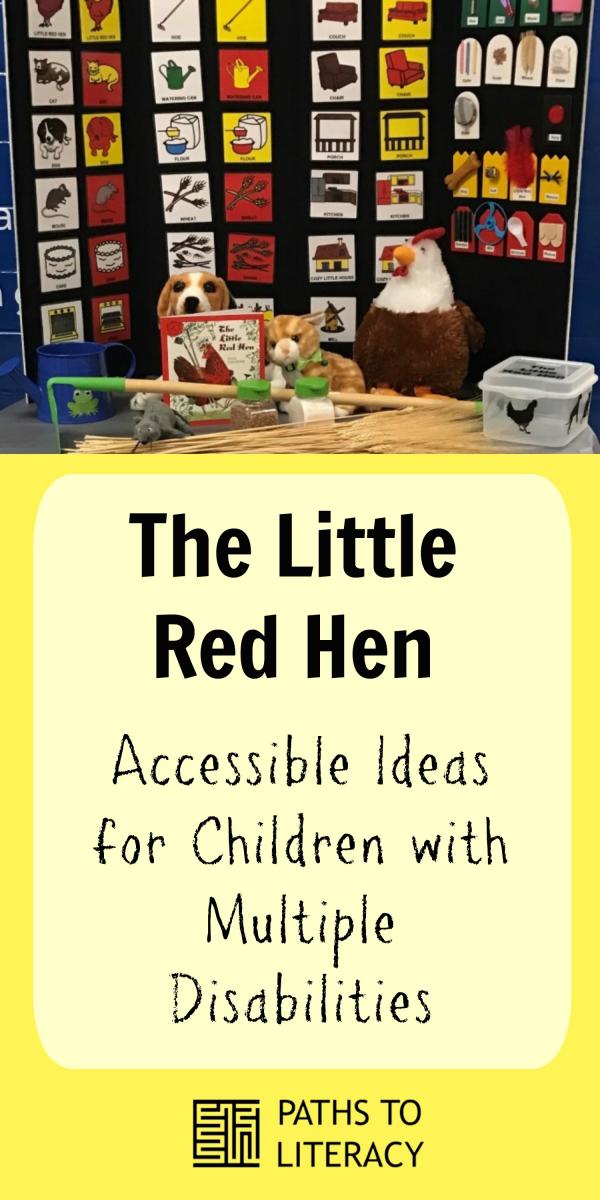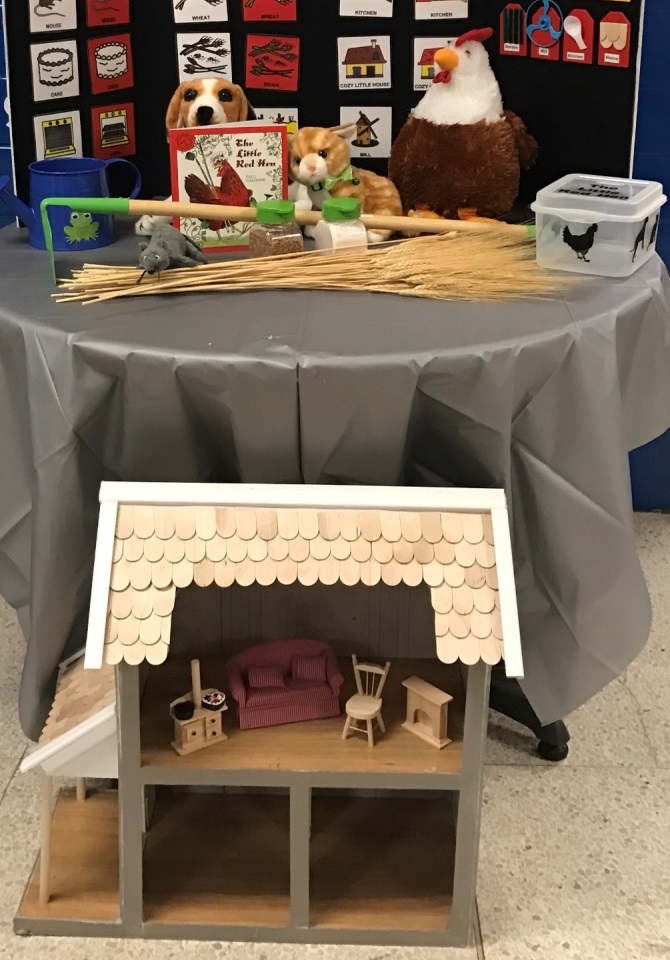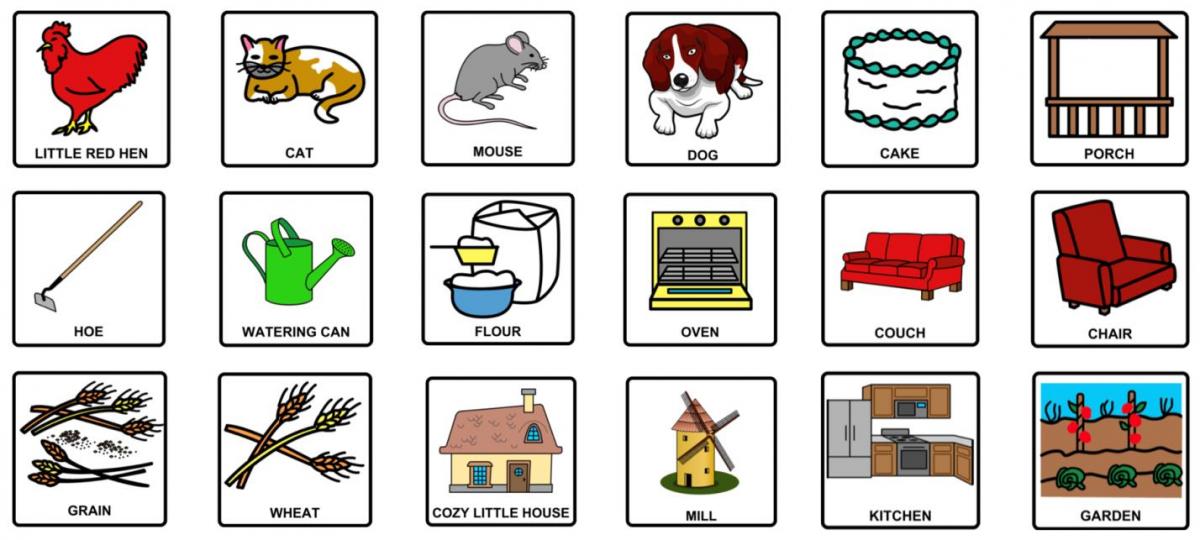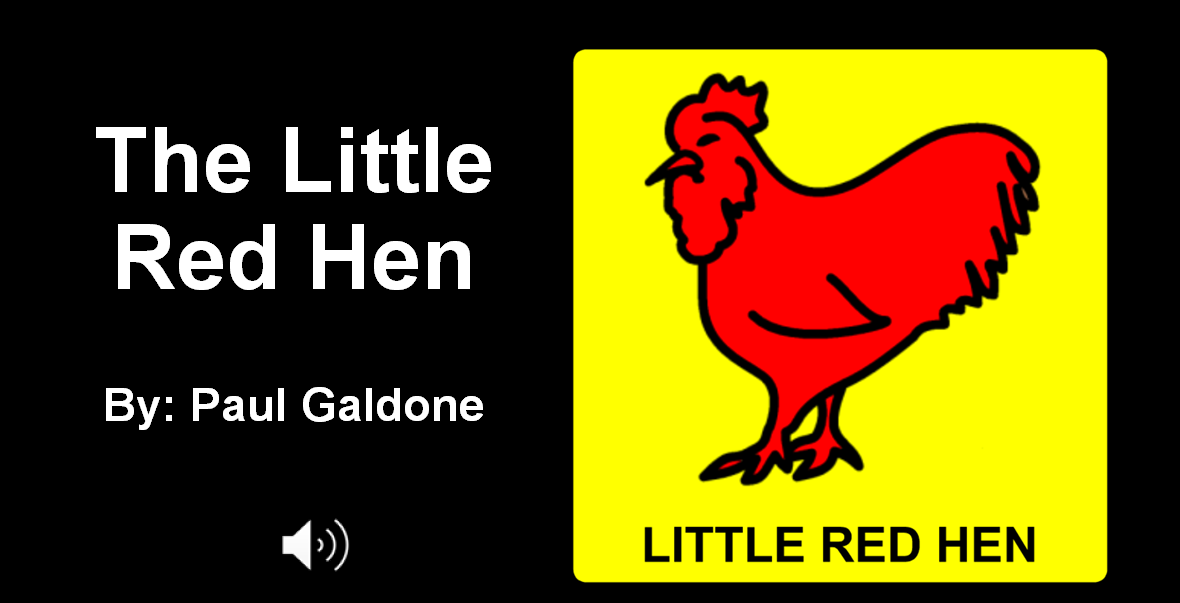"The Little Red Hen": Accessible Ideas for Children with Multiple Disabilities
Submitted by JasamynNichols on Apr 25, 2017
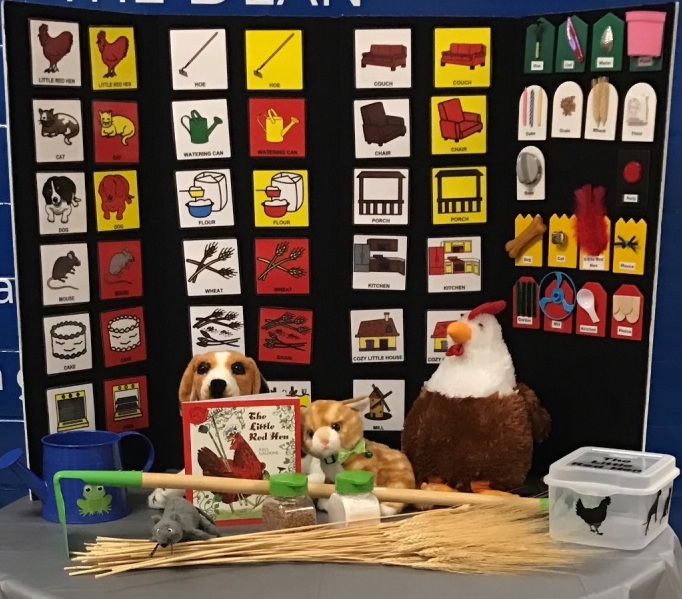
As part of the graduate coursework for Visual Impairments and Multiple Disabilities in the Teacher Preparation Program in Visual Impairments at the University of Kentucky, students were asked to complete four projects: Story Box, Picture Communication Symbols for Story Box, Tactile Communication Symbols, and Talking Book Project.
We are sharing them on Paths to Literacy and hope that others will use them! Please add your comments at the bottom of the page. This project is based on The Little Red Hen by Paul Galdone.
The Little Red Hen Story Box
The book I selected to adapt was The Little Red Hen, a classic story that everyone has heard, written by Paul Galdone. The most difficult challenge was finding a book to adapt. I wanted a book that I could use in some way with all my students with multiple disabilities.
The following are the objects included in my story box:
- Hen
- Dog
- Cat
- Mouse
- Wheat
- Grain
- Flour
- Hoe
- Watering can
- House with porch
- Oven
- Cake pan
- Couch
- Chair
- Fireplace
The first items I selected for my story basket were the characters: a hen, a cat, a dog, and a mouse. I found the hen at the Rural King for $4. I picked the hen with reddish tinted fur because of course the hen in the story is red. The hen has a tail, wings, a comb, wattle, and webbed feet. The dog is the same kind of dog as the one in the book. It is the most real life stuffed animal I have ever seen. It has floppy ears, a long tail, and toes just like a real dog. I selected a cat that has pointy ears, whiskers, and a long tail. I also added a collar with a bell. The mouse is small with a tail, whiskers, pointy nose, and ears. Next, I found the main objects needed for planting the wheat. The story tells us that the hen hoed the garden. I found a child-size hoe. I knew this would be an important concept to review because a student may have never heard of or know what a hoe is, whereas they may be familiar with a shovel. I also bought a watering can. I ordered wheat grain and flour and put them each in a container. I felt that it was very important to find something very close to the real thing, so I bought wheat berries. I was also able to find natural dried wheat at Hobby Lobby. The most challenging object I wanted was to have a porch. I asked my grandfather to build me a house with a porch. I knew that a porch was not an object that I could just go buy. I found a miniature chair, couch, fireplace, and oven with a cake on top to place inside the house. Although these are small objects, tactually a student would be able to process the concept of each, if they had already had real-life experience with the item.
Implementation Ideas
- Object Exploration During Story Telling: While the story is being read, the student will have the opportunity to explore each of the objects in the box as they are mentioned. This will also be a wonderful opportunity to gain background knowledge needed for the Boardmaker images and tactile symbol cards.
- Comprehension: Using objects in the story box, students can answer comprehension questions about the story.
- Retelling Story: The objects can be used to retell the story. The objects will also provide the students with the background knowledge needed for the picture cards and tactile symbol cards. Students can explore the object as it is being discussed/read in the story.
- Sequencing: Using the objects in the story box, students will be able to sequence the events of the story.
- Picture Object Identification: Use the All in One board and put two picture cards on it (ex. Cat and Dog). Present the object to the student. Ask them which one is the dog. Have the student take the dog off the board and hand it to you. Exchange the picture for the object.
Additional Activities
- Planting – You could plant flowers with your students. Reviewing the steps in the story, plant the seeds, water the seeds, etc.
- Baking A Cake – You could bake a cake like The Little Red Hen does in the story.
Picture Communication Symbols for Story Box
I created 18 symbols to represented the story, The Little Red Hen, by Paul Galdone. 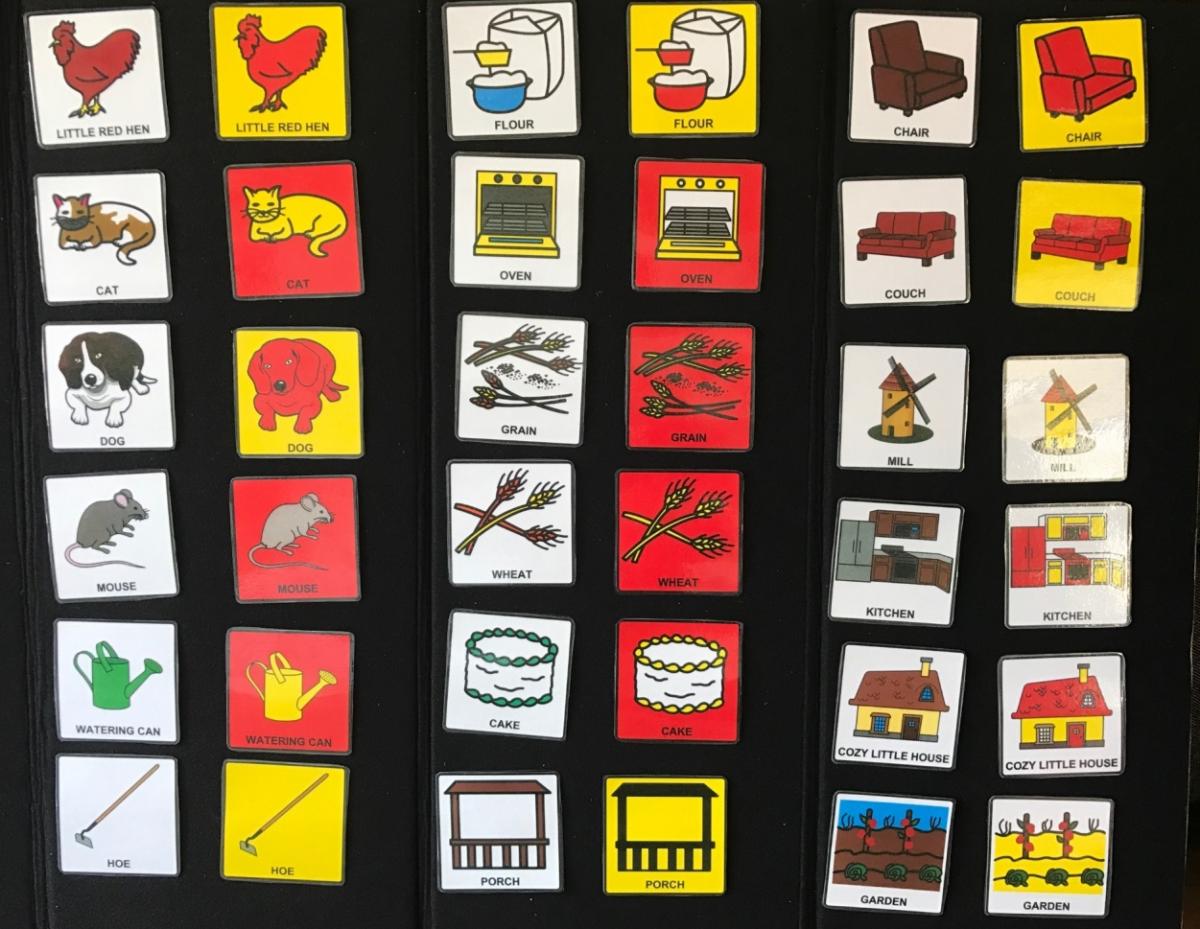

- Little Red Hen
- Cat
- Dog
- Mouse
- Watering can
- Hoe
- Flour
- Oven
- Grain
- Wheat
- Cake
- Porch
- Chair
- Couch
- Mill
- Kitchen
- Cozy Little House
- Garden
Each picture symbol card is printed on cardstock paper and laminated. A hook and loop fastener on the back. The cards are 4 inches by 4 inches with a thick, black border. The font is Arial 24 Bold. The picture symbols can be presented on an Invisiboard or All in One board.
First, I created symbols using original Boardmaker images and only made a few changes to the color.
There symbols can be used to retell the story or answer questions about the story. I would also use them with a student for object-picture identification. The student can be shown the object and select the matching image.
Questions
- Who are the characters in The Little Red Hen? Little Red Hen, Dog, Cat, Mouse
- Where did the mouse sleep? Chair
- Where did the cat sleep? Couch
- Where did the dog sleep? Porch
- What did the Little Red Hen find in the garden? Grain
- What did the Little Red Hen use to water the garden? Watering Can
- What tool does the Little Red Hen use in the garden? Hoe
- Where did the Little Red Hen plant the grain? Garden
- What does the wheat turn into at the mill? Flour
- What did the Little Red Hen bake with the flour? Cake
- Where did the Little Red Hen take the wheat to be turned into flour? Mill
- What room in the house do you bake a cake? Kitchen
- Where did the characters live in the story? Cozy Little House
- What does the Little Red Hen bake the cake in? Oven
Tactile Communication Symbols
Using the Tactile Connections Kit from APH, I created 18 symbols to represent the story The Little Red Hen by Paul Galdone.
- Little Red Hen
-
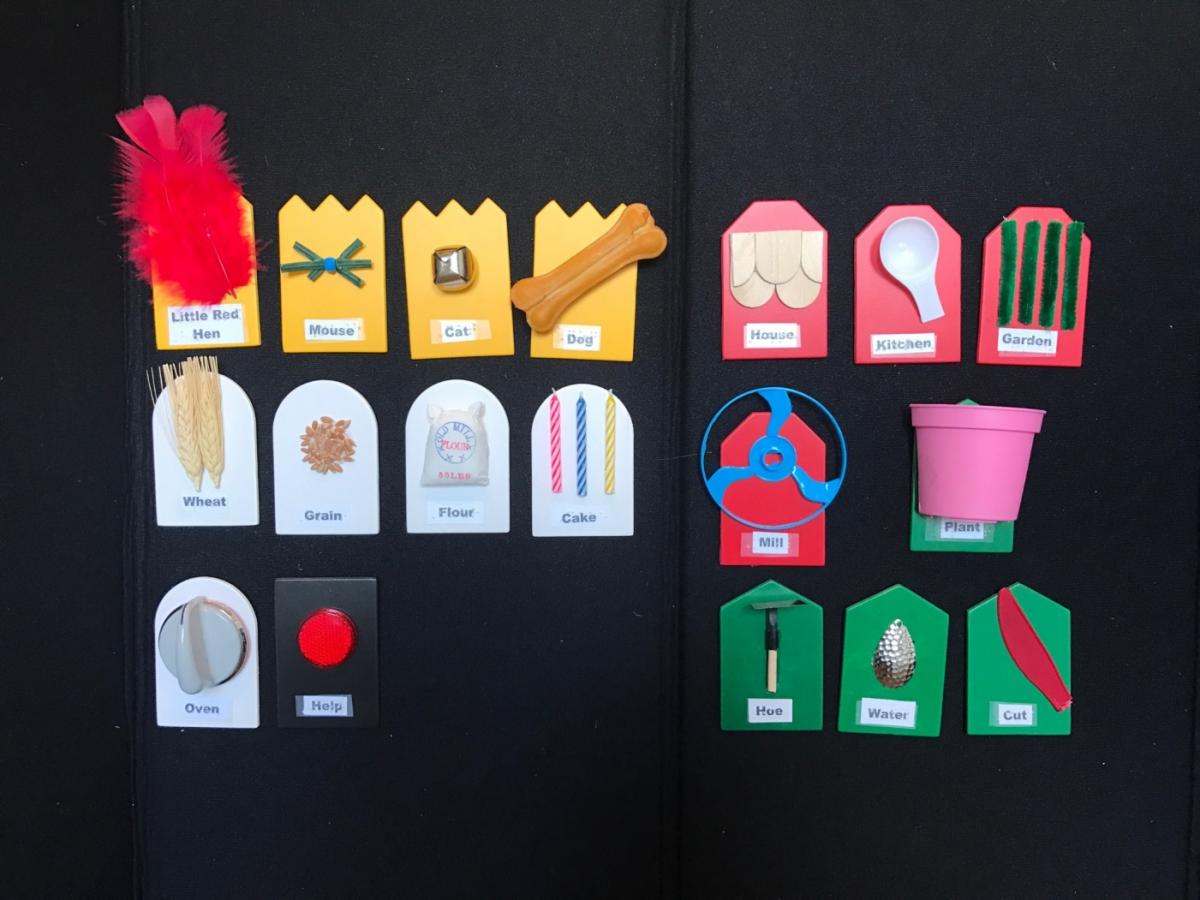 Mouse
Mouse - Dog
- Cat
- Wheat
- Grain
- Oven
- Flour
- Cake
- Help
- House
- Kitchen
- Garden
- Mill
- Plant
- Hoe
- Cut
- Water
The first step in this process was to look at the different categories of Tactile Connections cards.
| Category | Color | Shape |
|---|---|---|
| Person | Yellow | Crown |
| Place | Red | Barn |
| Action | Green | House |
| Time | Blue | Puzzle |
| Object | White | Bread |
| Expression | Black | Rectangle |
| Expansion | Gray | Scalloped |
Next, I went through the book to find symbols for each category. (Note: Not all categories were used.)
| Symbol | Category | Explanation |
|---|---|---|
| Little Red Hen | Person | Character in the story. |
| Dog | Person | Character in the story. |
| Cat | Person | Character in the story. |
| Mouse | Person | Character in the story. |
| Wheat | Object | Main object in the story. |
| Grain | Object | Main object in the story. |
| Oven | Object | Main object in the story. |
| Flour | Object | Main object in the story. |
| Cake | Object | Main object in the story. |
| Help | Expression | The Hen asks the other characters for help throughout the entire story. |
| House | Place | Setting in the story. |
| Kitchen | Place | Setting in the story. |
| Garden | Place | Setting in the story. |
| Mill | Place | Setting in the story. |
| Plant | Action | Action involved in growing the wheat. |
| Hoe | Action | Action involved in growing the wheat. |
| Cut | Action | Action involved in growing the wheat. |
| Water | Action | Action involved in growing the wheat. |
I then created a print label (Arial, bold, 24 font) and a braille label for each card. Next, I had to determine what tactile element to added to each card.
| Symbol | Tactile Element | Reason tactile element was selected and background knowledge needed |
|---|---|---|
| Little Red Hen | Red feathers | Hens have feathers and the title of the book tells us the hen is red. |
| Dog | Bone | Dogs like to chew on bones. It is a common object that represents a dog. (ex. dog tags shaped as bones) |
| Cat | Bell | Most cats have a collar or play with toys that have bells. I added a collar with a bell to the cat in my story box. |
| Mouse | Bead and bread ties | A mouse has whiskers on its face. I used a bead to represent the tip of the nose and bread ties for the whiskers. |
| Wheat | Natural dried wheat | I used actual naturally dried wheat. |
| Grain | Wheat grain | I used real wheat grain. |
| Oven | Oven knob | I used a piece of an oven that a student would know if they have ever used an oven. |
| Flour | Small bag filled with cotton | I couldn't put actual flour on the card. So, I found a small bag that could represent the small bag of flour in the book. |
| Cake | Candles | Students know that you blow out candles on a cake. |
| Help | Reflective circle sticker | Student could be taught that shiny, red reflector/lights mean help/emergency. |
| House | Popsicle sticks | I used the same shingle pattern as the house I made for my story box. |
| Kitchen | Measuring spoon | You use measuring spoons in the kitchen. |
| Garden | Green pipe cleaners in rows | Gardens are planted in rows. And most color in the garden is green. |
| Mill | Wheel toy | A mill has a large fan on the building and a wheel outside moving water. |
| Plant | Half a flower pot | Students may have planted flowers in a pot. |
| Hoe | A miniature hoe | I used a miniature hoe pointed up so the student could feel the flat end on the hoe. |
| Cut | A plastic knife | Knives are used to cut. I couldn't fit a pair of scissors on the card and plastic would not cut the child's finger when they feel it. |
| Water | Metal piece shaped like a water droplet and texture. | Students can be taught that a water droplet is shaped like this. |
I found a clear plastic container that would store all my tactile communication symbols. I added vinyl stickers to the container including the title, a hen, cat, dog, mouse, and wheat. Braille labels were also added.
Students can answer the following comprehension questions about The Little Red Hen with the tactile communication symbols.
- Who did all the housework? Little Red Hen
- Who slept on the porch? Dog
- Who slept on the couch? Cat
- Who slept on the chair? Mouse
- What is the setting of the story? House
- Where does the Little Red Hen plant the grain? Garden
- Where does the Little Red Hen take the wheat to be turned into flour? Mill
- Where does the Little Red Hen bake the cake? Kitchen
- What did the Little Red Hen find while hoeing in the garden? Grain
- What does the grain grow to be? Wheat
- What does the wheat turn into at the mill? Flour
- What does the Little Red Hen bake with the flour? Cake
- What does the Little Red Hen bake the cake in? Oven
- What did the Little Red Hen keep asking for? Help
Sequencing: Using the tactile symbols, Plant, Hoe, Water, and Cut, I would ask the students to think about the steps the Little Red Hen took with the wheat. The student can sequence the steps in planting wheat.
Retelling: Using the tactile symbols, the students can retell the story.
Talking Book
This talking book was created with Boardmaker images and adapted for children with CVI.
